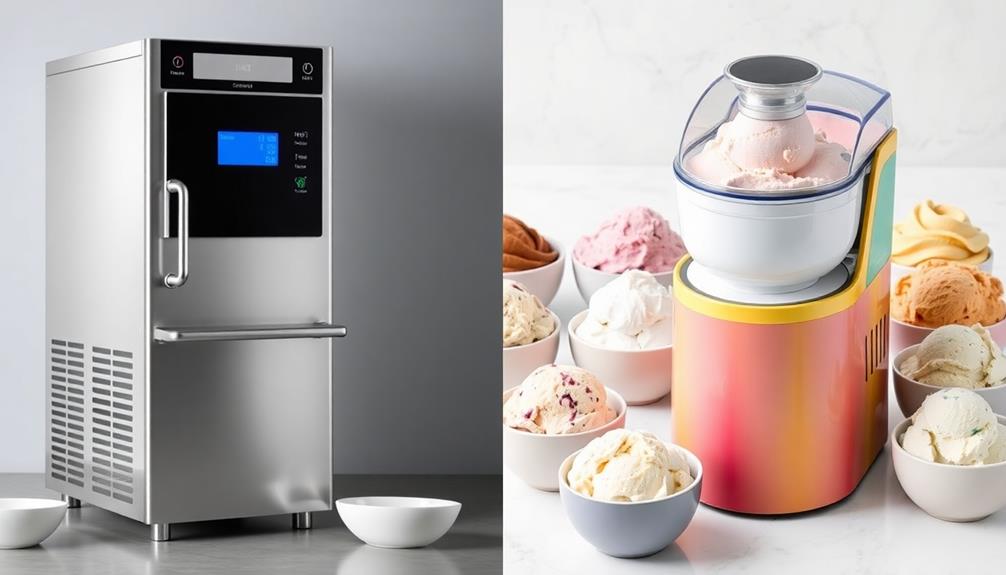When it comes to ice cream machines, commercial and home models serve different purposes. Commercial machines churn out 30-150 quarts per hour, perfect for busy restaurants or ice cream parlors. They're built for speed and require more maintenance. In contrast, home machines produce 1-5 quarts per batch, suited for casual use and needing less upkeep. They take longer to freeze and often rely on pre-frozen bowls. While commercial units offer superior durability and advanced technology, home machines are budget-friendly and compact. Curious about which type fits your needs best? There's more to uncover in this tasty comparison!
Key Takeaways
- Commercial ice cream machines produce 30-150 quarts per hour, while home machines typically produce 1-2 quarts per batch.
- Commercial machines require more space and robust plumbing, whereas home machines are compact and fit on countertops.
- Advanced technology in commercial machines ensures smoother texture and quicker production compared to home models.
- Pricing varies significantly; commercial machines cost between $3,000 and $25,000, while home machines range from $50 to $500.
- Commercial units are ideal for high-volume settings, while home machines cater to casual users and small batches.
Overview of Ice Cream Machines
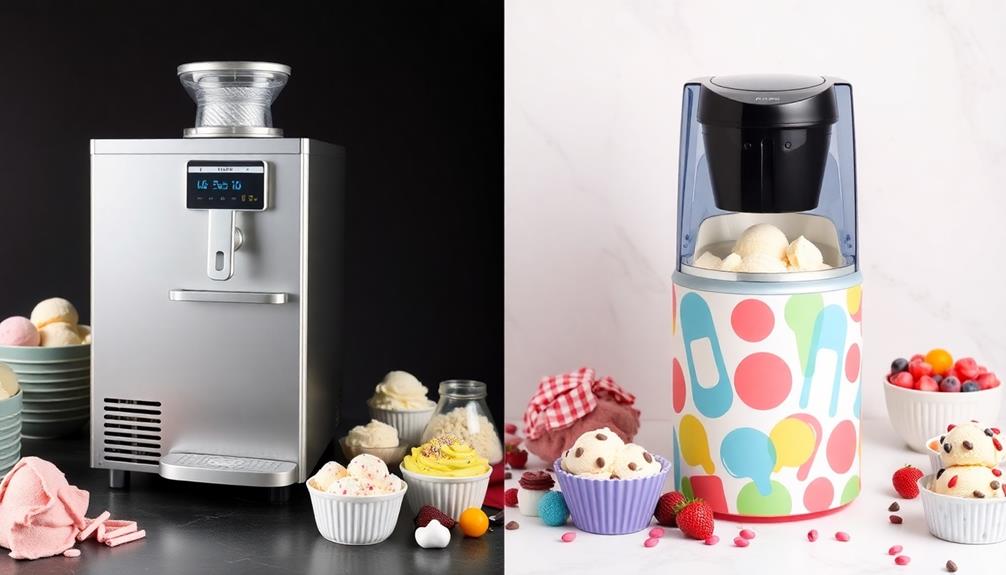
Ice cream machines are an essential tool for anyone looking to create delicious frozen treats, whether for personal enjoyment or commercial purposes.
When it comes to ice cream production, you'll find two main types: commercial ice machines and home ice makers. Commercial models are built for high-capacity output, allowing businesses like restaurants and bars to produce large quantities quickly. Their durability and performance are designed to meet the demands of a bustling environment, operating continuously without faltering.
On the other hand, home ice makers cater to personal use, perfect for small gatherings or occasional treats. While they're more affordable, they lack the capacity and robustness of their commercial counterparts.
Maintenance requirements also differ considerably; commercial ice machines necessitate regular cleaning and high-quality water to maintain peak performance, while home models can typically run on tap water with less frequent upkeep.
Key Differences in Capacity
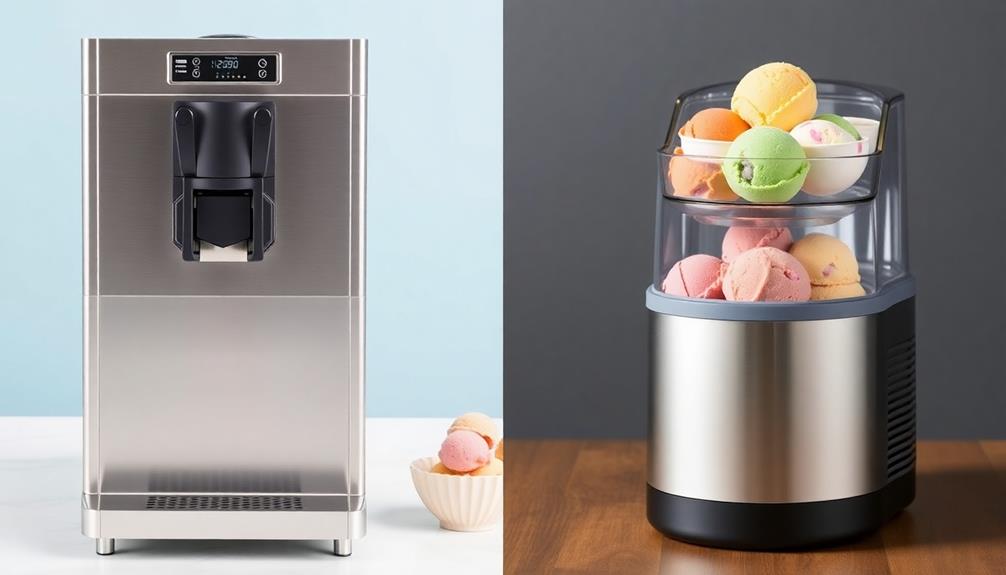
When you compare commercial and home ice cream machines, you'll notice a significant difference in production volume.
Commercial units churn out anywhere from 30 to 150 quarts per hour, while home models typically handle just 1 to 5 quarts per batch.
This stark contrast not only affects the speed of ice production but also has implications for space requirements in your kitchen or business.
Production Volume Comparison
In the world of ice cream machines, capacity plays a crucial role in determining efficiency and suitability for different settings. Commercial machines boast a production capacity ranging from 30 to 150 quarts per hour, making them ideal for restaurants and ice cream parlors that face high demand during peak hours.
In contrast, home machines typically produce only 1 to 2 quarts per batch, catering to personal use and smaller gatherings. This significant difference in output speed affects how businesses operate.
With the ability to churn out ice cream in minutes, commercial machines guarantee a consistent supply, keeping customers satisfied and minimizing wait times. Meanwhile, home machines often take several hours due to pre-freezing requirements, making them less practical for larger events.
Moreover, the price of commercial machines often reflects their efficiency and production capacity. Higher-end models are designed for maximum output and durability, while home machines prioritize affordability, sacrificing some capacity.
Ultimately, if you're looking to serve a steady stream of customers, investing in a commercial machine is a smart choice. For casual use, however, a home machine will suffice.
Speed of Ice Production
The speed at which ice cream is produced can considerably impact your operations, especially in a commercial setting. You need to serve customers quickly, and that's where commercial ice cream machines shine. These machines can whip up a batch of ice cream in as little as 12 minutes, while most home models can take hours to achieve similar results.
When it comes to production capacity, commercial machines can produce anywhere from 2 quarts for countertop models to an impressive 150 quarts per hour for heavy-duty units. This flexibility allows you to cater to high-demand environments efficiently.
In contrast, home models typically require pre-frozen bowls, limiting your output per batch and making it challenging to keep up during busy hours.
The continuous operation capability of commercial machines enables rapid production, ensuring you can serve customers without long waits. This efficiency not only enhances your service speed but also boosts overall customer satisfaction, making it easier for you to thrive in a competitive market.
If you're serious about your ice cream business, investing in a commercial machine is the way to go.
Space Requirements Analysis
Space considerations are essential when choosing between commercial and home ice cream machines. You need to assess the capacity required for your needs and the space available for installation.
Commercial machines typically handle large production volumes, ranging from 2 quarts to an impressive 150 quarts per hour. This makes them ideal for restaurants or ice cream parlors that experience high demand.
On the other hand, home machines usually produce about 1 to 2 quarts per batch, perfect for personal use or small gatherings.
Here are a few key differences:
- Space Requirements: Commercial machines need dedicated areas, while home machines fit easily on countertops.
- Plumbing Needs: Commercial setups require more robust plumbing and electrical systems, whereas home machines only need standard outlets.
- Operational Capacity: Commercial machines are designed for continuous operation, while home machines typically function in batches.
Understanding these differences will help you make an informed decision based on the space and capacity you have available.
Choose wisely to guarantee you meet your ice cream-making needs without overcrowding your kitchen or business space.
Production Speed Comparison
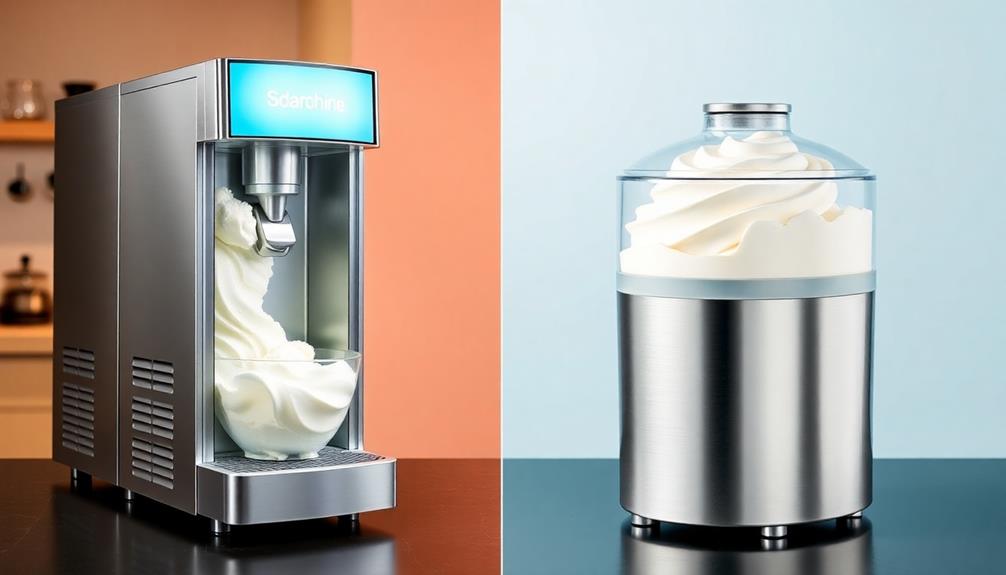
When you compare production speed, commercial ice cream machines outpace home models greatly.
While a commercial unit can churn out ice cream in just 12 minutes and handle large quantities, home machines often take several hours and produce only about 1 quart at a time.
This efficiency makes commercial machines a better fit for busy settings, where quick service is essential.
Commercial Machine Efficiency
Typically, commercial ice cream machines outpace home models considerably in production speed and efficiency. Unlike home machines that require several hours due to pre-frozen bowls, commercial units can produce ice cream in as little as 12 minutes. Their production speed is impressive, ranging from 50 quarts per hour for low-capacity models to over 150 quarts per hour for heavy-duty machines. This guarantees high output during peak service times, making them ideal for busy ice cream parlors.
Here are some key benefits of commercial machine efficiency:
- Automated processes, allowing for continuous operation without manual intervention
- Ability to produce large quantities while maintaining consistent quality and texture
- Designed to meet the demands of high-volume settings, assuring rapid production
With built-in freezers, commercial ice cream machines enhance efficiency, catering perfectly to the needs of restaurants and parlors.
This means you can keep up with customer demand while serving delicious ice cream that's always ready to go. If you're serious about ice cream production, investing in a commercial machine might be the best choice for your business.
Home Machine Limitations
Home ice cream machines often struggle to keep up with the demands of ice cream enthusiasts due to their inherent limitations in production speed. With a longer production time compared to commercial machines, these domestic models can be quite frustrating when you're craving a quick treat.
Here's a quick comparison of the key differences:
| Feature | Home Ice Cream Machines | Commercial Machines |
|---|---|---|
| Production Time | 20-40 minutes per batch | Minutes per batch |
| Capacity | 1-2 quarts per batch | Up to 150 quarts/hour |
| Freezing Process | Requires pre-frozen bowls | Churns and freezes simultaneously |
The lower capacity of home ice cream machines means you can only make a small batch at a time. Additionally, the freezing process hinders efficiency, as these machines need breaks between batches to refreeze the bowl. Unlike commercial machines with advanced features like automatic consistency control, home models lack the technology to enhance production speed. For those who want to whip up ice cream quickly and efficiently, investing in a commercial machine might be the better choice.
Production Time Variances
While many ice cream lovers appreciate the convenience of home machines, the stark differences in production time between commercial and domestic models can be frustrating.
Commercial machines can whip up a batch of ice cream in as little as 12 minutes, while home models often take several hours to freeze the mixture. This significant variance in production time can be a game-changer, especially if you're serving a crowd.
- Larger capacity: Commercial machines can produce between 2 to 150 quarts per hour, guaranteeing you keep up with high demand.
- No pre-freezing required: Unlike home models, commercial machines have integrated freezing systems that allow for immediate production without waiting for pre-freezing bowls.
- Optimal temperature maintenance: Advanced churning and cooling mechanisms guarantee consistent, rapid output, delivering ice cream with the perfect texture.
In contrast, home machines require manual operation and frequent monitoring, which can further delay the process.
If you value speed and efficiency, the production time differences between commercial and home models will be evident, making commercial ice cream machines the clear winner for those serious about ice cream production.
Durability and Maintenance Needs
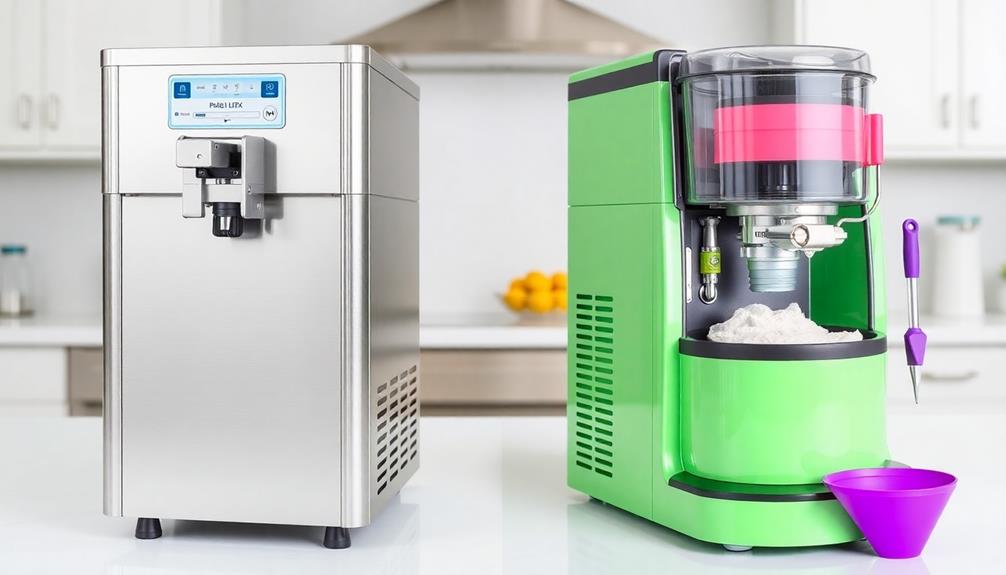
When choosing between commercial and home ice cream machines, durability and maintenance needs play an essential role. Commercial machines are built for high durability, designed to endure continuous use in busy settings. Their construction quality often includes stainless steel components, enhancing longevity.
In contrast, home ice cream makers focus on lighter, less frequent usage, utilizing more plastic-based designs.
Because commercial machines operate constantly, they require regular maintenance. This means you'll need to engage in frequent cleaning and servicing to maintain ideal performance and hygiene. Adhering to specific operational guidelines is critical for these units to function effectively.
On the other hand, home ice cream makers demand much less maintenance. You can use lower-quality water without greatly impacting their performance, making them suitable for casual users.
If you're considering your options, remember that commercial machines might require professional installation, while home units are designed for straightforward, at-home setups.
Functionality and Technology Features
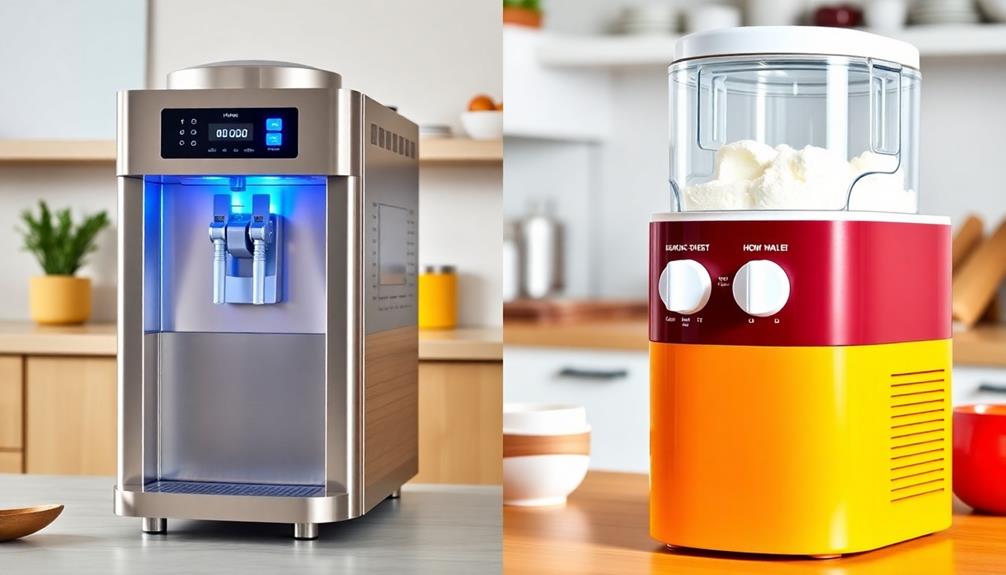
When you compare commercial and home ice cream machines, you'll notice significant differences in their operational mechanisms and technology features.
Commercial models are designed for quick production and efficiency, utilizing advanced components like built-in freezers and intelligent programs.
In contrast, home machines usually rely on pre-frozen bowls and simpler mixing techniques, which can limit your ice cream-making experience.
Operational Mechanisms Comparison
Comparing the operational mechanisms of commercial and home ice cream machines reveals significant differences in functionality and technology features.
Commercial ice cream machines are designed for efficiency and speed, often including built-in freezers that allow you to produce ice cream in minutes. In contrast, home machines usually require pre-frozen bowls and take hours to make a batch.
Here are some key differences you'll notice:
- Production Capacity: Commercial machines can produce anywhere from 2 to 150 quarts per hour, while home machines are limited to smaller batches.
- Churning Mechanism: The continuous mixing in commercial machines incorporates air effectively, ensuring a smooth texture and ideal consistency and flavor. Home machines may lack this sophistication, resulting in less consistent textures.
- Advanced Features: Commercial models often include features like density control switches and programmable settings, enhancing their freezing capabilities. These advanced features are typically absent in home machines.
Technology Integration Differences
Understanding the differences in operational mechanisms sets the stage for exploring technology integration in ice cream machines.
When it comes to commercial ice cream machines, you'll find advanced technology that streamlines production and enhances quality. These machines feature built-in freezers, allowing immediate production, unlike home machines that require pre-frozen bowls. This means you can whip up a batch in as little as 12 minutes, while home models might take several hours, affecting your service efficiency.
Commercial machines are packed with specialized components like hoppers and freezing cylinders, enabling them to handle diverse dessert offerings. The operational flow in these machines is finely tuned, balancing freezing and aeration to create smooth textures, a feature often lacking in home models.
With intelligent programs and density control switches, commercial machines optimize consistency and prevent damage from overly hard mixtures, ensuring every batch meets high standards.
In contrast, home machines typically have limited functionality and fewer custom options, making them less adaptable for varied recipes.
If you're serious about ice cream, investing in a commercial machine means embracing advanced technology that elevates your dessert game.
Cost Considerations and Pricing
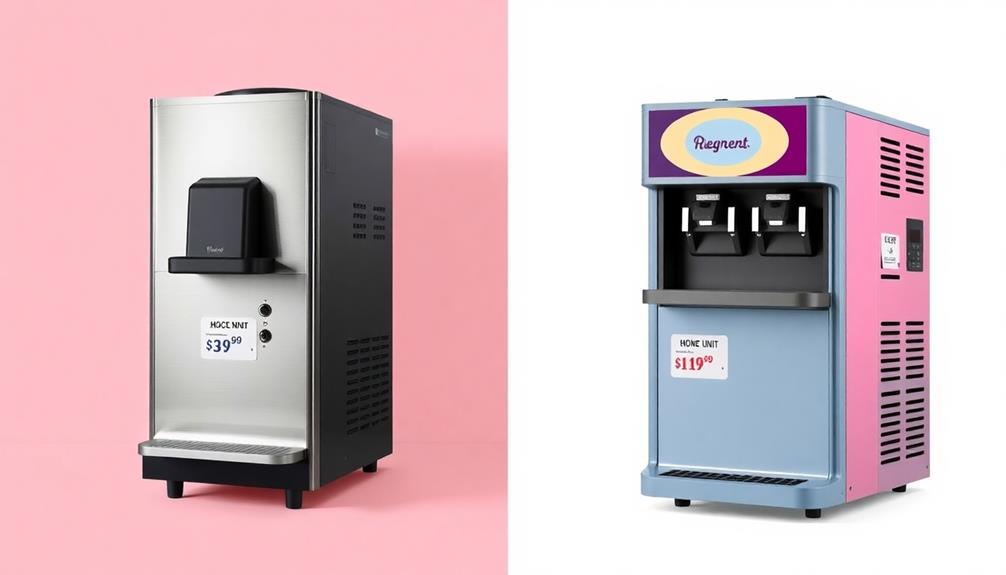
Investing in an ice cream machine can feel intimidating, especially with the significant price differences between commercial and home models. When you consider cost considerations and pricing, it's clear that the upfront cost is a major factor in your decision.
- Commercial machines range from $3,000 to $25,000, whereas home machines typically cost between $50 and $500.
- The higher investment in commercial models is due to their durability, capacity, and speed, designed for high-volume production.
- Operating costs for commercial machines are usually lower per serving, enhancing profitability through efficient bulk ingredient usage.
While home machines are more affordable, they often lack the advanced features and consistent output quality that commercial models offer.
This means that if you're running a business, the initial investment in a commercial machine can lead to quicker returns due to faster production rates.
Ultimately, it's about weighing the upfront cost against the potential for profitability and reduced operating costs. Making the right choice will depend on your goals and how you plan to use your ice cream machine.
Types of Machines Available
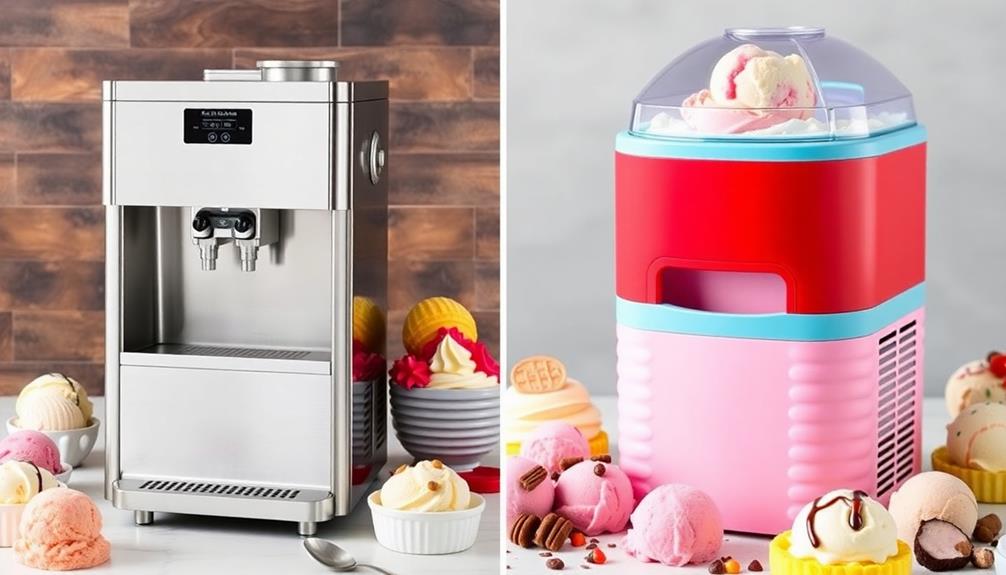
Exploring the different types of ice cream machines available can help you make an informed decision based on your needs. There are two primary categories: commercial and domestic machines. Commercial ice cream machines include soft serve machines and batch freezers, designed for high volume production in settings like ice cream shops. In contrast, domestic ice cream makers are smaller and more suited for home use.
Here's a quick comparison of the types of machines:
| Machine Type | Features |
|---|---|
| Commercial Ice Cream Machine | High capacity, 2 quarts to over 150 quarts per hour |
| Soft Serve Machines | Dispense on-demand, ideal for fast-paced environments |
| Batch Freezers | Produce single batches, customizable ingredients |
| Domestic Ice Cream Makers | Limited capacity, typically 1 to 2 quarts per batch |
Understanding these capacity differences and the types of ice cream machines available will help you choose the right option for your needs. Whether you're running an ice cream shop or just making treats at home, knowing your options is key to success!
Flavor and Texture Consistency
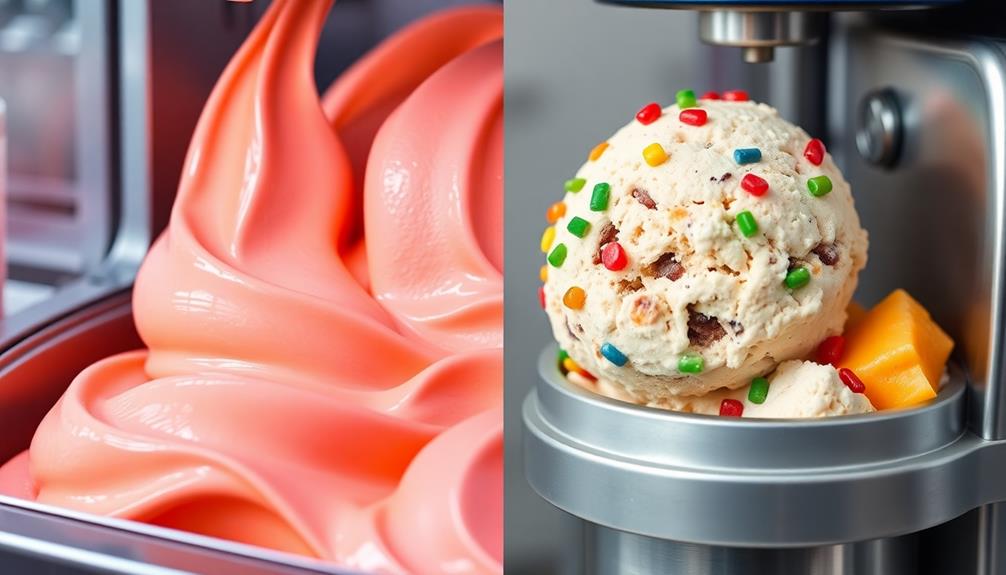
When choosing between commercial and home ice cream machines, flavor and texture consistency play a significant role in your decision.
Commercial ice cream machines excel in delivering a smoother and creamier product due to their advanced churning and freezing mechanisms. These machines allow for precise control over texture and flavor consistency, guaranteeing every batch meets high standards.
Here are some key advantages of commercial machines:
- Higher air incorporation (overrun) for lighter, fluffier ice cream.
- Fresh production capabilities that enhance flavor profiles and maintain quality.
- Quick production times to minimize fluctuations in texture and flavor.
Commercial machines also feature density control switches, preventing damage from overly hard mixtures. This guarantees that the ice cream maintains its intended texture during production.
On the other hand, home machines often produce denser textures, leading to variability in the final product. If you value consistent flavor and texture, investing in a commercial ice cream machine is a wise choice, especially for those looking to satisfy customers or elevate their homemade creations.
Ideal Use Cases for Each Type
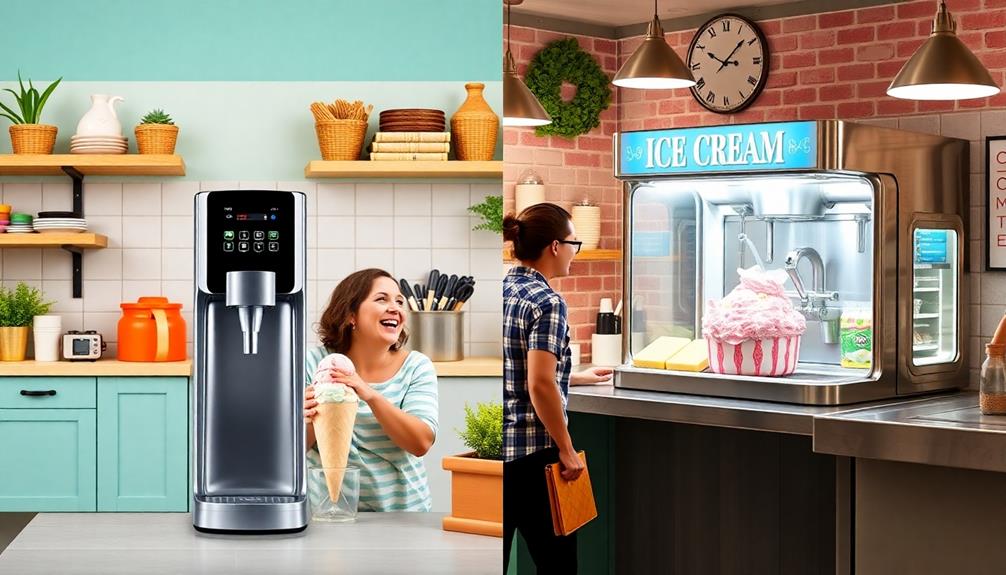
Considering your specific needs can help you decide between commercial and home ice cream machines.
If you're running a restaurant or an ice cream parlor, commercial ice cream machines are your best bet. They're designed for high-volume production, allowing you to churn out 50 to over 150 quarts of ice cream per hour.
For environments like amusement parks or food trucks, soft serve machines are ideal, providing on-demand ice cream and multi-flavor options for quick service.
On the other hand, if you're a casual user looking to whip up some treats at home, home ice cream makers are the way to go. They produce small batches, perfect for families or individuals who enjoy making ice cream occasionally.
If you love experimenting with unique flavors, batch freezers are excellent for small artisanal ice cream shops. They allow for customization and creativity in limited quantities.
Choosing the Right Machine
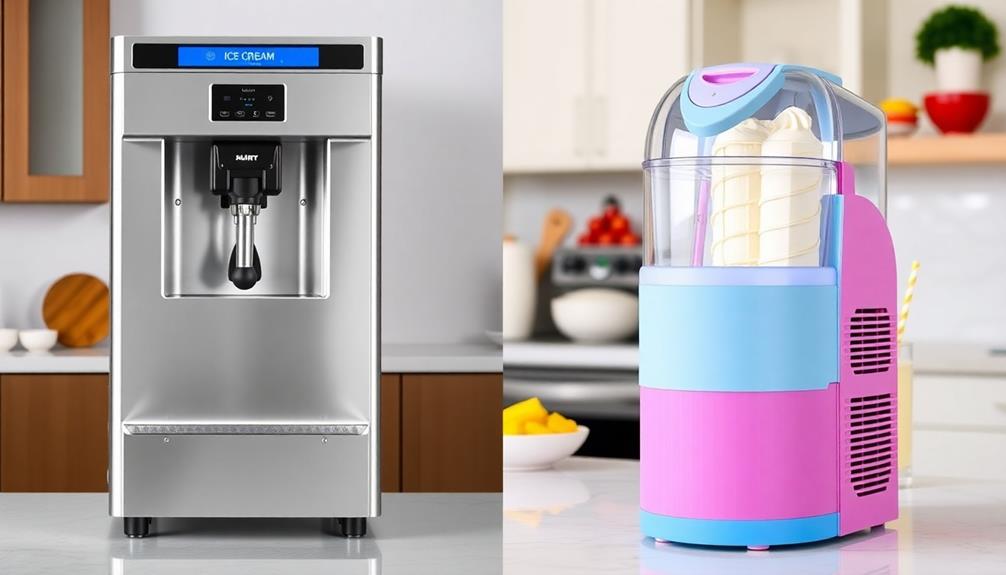
Selecting the right ice cream machine hinges on your specific needs and usage. If you're running a business or often hosting events, a commercial ice cream machine is your best bet. These machines boast high capacity, producing between 2 to 150 quarts per hour, perfect for whipping up a variety of frozen desserts like soft-serve and gelato.
On the other hand, if you're making ice cream for personal enjoyment, home ice cream makers may suffice, typically churning out 1 to 2 quarts per batch with longer production times.
When choosing a machine, consider these factors:
- Price: Commercial machines have a higher upfront cost, while home models are budget-friendly.
- Maintenance and Cleaning: Commercial units require more frequent upkeep, while home machines need less maintenance.
- Functionality: Decide what types of frozen desserts you wish to create; commercial machines offer more variety.
Ultimately, understanding your production needs, budget, and desired dessert types will guide you in choosing a machine that fits your lifestyle and goals.
Frequently Asked Questions
What Is the Difference Between Commercial and Homemade Ice Cream?
When you compare commercial and homemade ice cream, you'll find commercial varieties offer superior texture, consistency, and production speed. Homemade ice cream, while delicious, often lacks that professional quality and uniformity you'd expect from store-bought options.
What to Consider When Buying an Ice Cream Machine?
When choosing your ice cream machine, think of it as a canvas. You'll want the right capacity, user-friendly controls, durable materials, quick freezing times, and solid warranties to create your masterpiece efficiently and reliably.
How Long Does It Take a Commercial Ice Cream Machine to Make Ice Cream?
A commercial ice cream machine can whip up ice cream in just 12 minutes. Its powerful motor and built-in freezer let you churn out large quantities quickly, making it perfect for busy environments needing consistent supply.
What Are the Different Types of Ice Cream Machines?
You'll find various types of ice cream machines, including manual, electric, compressor, soft serve, and batch freezers. Each type caters to different needs, from home use to commercial production, offering distinct advantages and ice cream styles.
Conclusion
To sum up, choosing between a commercial and a home ice cream machine boils down to your specific needs. If you're running a bustling ice cream shop like "Scoops & Smiles," a commercial machine's speed and capacity will keep your customers happy. On the other hand, if you're just an ice cream enthusiast making treats for family gatherings, a home machine will do the trick. Understanding these differences helps you make the best choice for your ice cream adventures!
